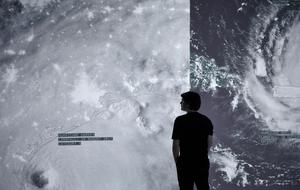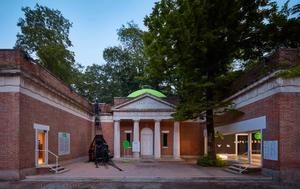
INPLAINSIGHT
GIARDINIDELLABIENNALE,VENICE,ITALY
The installation In Plain Sight is a collaboration among Diller Scofidio + Renfro, Laura Kurgan, and Robert Gerard Pietrusko, with Columbia Center for Spatial Research. The installation is conceived and designed for Dimensions of Citizenship, the US Pavilion at the 16th International Architecture Exhibition of La Biennale di Venezia, commissioned by the School of the Art Institute of Chicago and The University of Chicago.
Today, using data collected by governments and satellite sensors, global populations and settlements can be counted and made visible. Although the data show us ways in which humans have organized the planet, registering sites of exclusion and expulsion is challenging.
This is a question of representation. Twice a day, twelve hours apart, a new image of Earth is scanned and saved by the Soumi National Polar Partnership satellite and its sensors. The 1:30 p.m. daytime image, assembled from data gathered over a number of days, shows a cloudless Blue Marble reminiscent of the 1972 image of Earth from Apollo 17 that gave us an icon for a unified global humanity. The 1:30 a.m. nighttime image, similarly composited, forms a Black Marble, a cloudless view of lights across the planet that reveal major population centers and reveal the global extent of our human footprint, an illusion of a connected world. NASA sensors, however, also show us the gaps in the network: the individual lights and the zones where lights are missing.
Black Marble imagery doesn't simply represent this world—it actively constructs it. Data is put to work by a range of political and economic actors to craft policies and interventions organized around a set of parallel binary oppositions: urban-rural, developed-undeveloped, rich-poor. Zooming in, clues become visible in the anomalies, the places with many people and no lights, and those with bright lights and no people—political and social conditions demanding that all people be counted.
In Plain Sight reveals anomalies and the consequent perils at the core of this binary world view. Visitors are shown places in the world with many people and no lights, and those with bright lights and no people, and are suspended between day and night and light and darkness— exposed to the political and social realities of being
invisible in plain sight.
| Location Giardini della Biennale, Venice, Italy |
| Team | Elizabeth Diller,Ricardo Scofidio,James McNally,Matthew Johnson,Cara Roberts,Youxin Chen,and Kumar Atre |
| Laura Kurgan | |
| Robert Gerard Pietrusko | |
| Columbia Center for Spatial Research |


